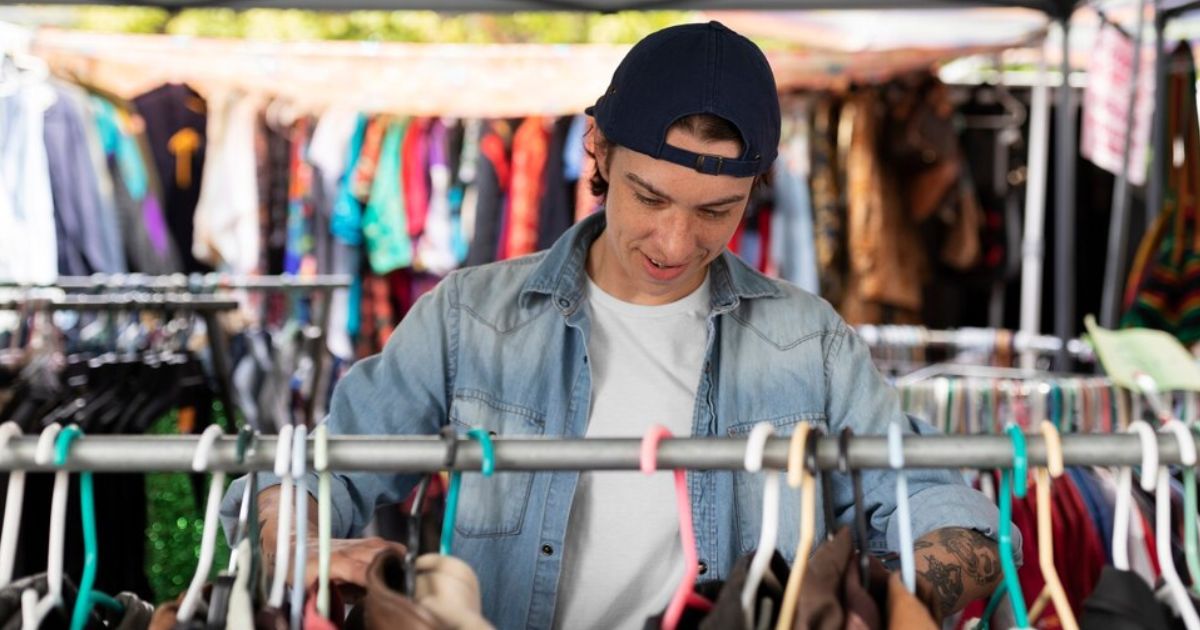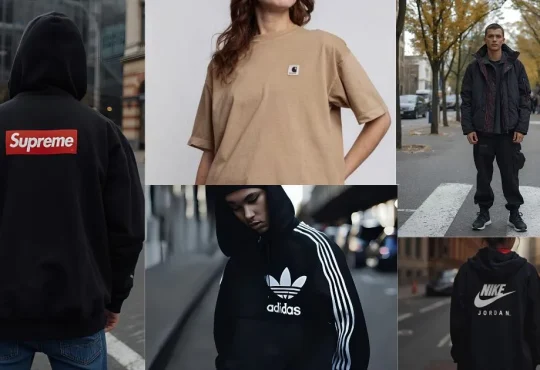
The retail landscape is dramatically transforming, led by a powerful secondhand surge. Fueled by digital resale platforms, eco-conscious consumers, and a passion for unique, vintage finds, the Thrift 3.0 movement has evolved from a niche trend into a dominant force in modern commerce. What was once a budget-friendly alternative has become a mainstream lifestyle and a cornerstone of sustainable shopping. As 2025 unfolds, the resale market is set to outpace traditional retail, driven by innovation, affordability, and environmental impact. This article dives into the rise of Thrift 3.0, the reasons behind its explosive growth, and the future of the booming secondhand economy.
How Sustainability Fuels the Secondhand Surge
A significant driving force behind Thrift 3.0 is the evolution of consumer values, mainly the increasing focus on sustainability. Today’s consumers—especially millennials and Gen Z—are more aware than ever of the environmental impact of their purchasing decisions. From fast fashion to single-use plastics, the modern retail industry has been scrutinized for its contribution to pollution, waste, and overconsumption.
On the other hand, resale markets offer an attractive alternative to the linear take-make-dispose retail model. Thrift 3.0 centres on the circular economy, where products are reused, upcycled, and resold. This shift is aligned with growing concerns about climate change and waste reduction. Studies show that buying secondhand clothing reduces carbon emissions by up to 82% compared to purchasing new items. Resale is no longer just a trend—it’s a sustainable choice for the eco-conscious consumer who wants to reduce their environmental footprint.
As the demand for eco-friendly products increases, consumers are drawn to resale platforms and thrift stores that align with their values. The ease of shopping for pre-loved items and the knowledge that their purchases support sustainable practices make resale a natural choice for many shoppers. Whether it’s clothing, electronics, or furniture, consumers are shifting away from new retail to favor products with a second life.
Digital Resale Platforms: The E-Commerce Revolution
The rapid growth of digital resale platforms has played a pivotal role in the rise of Thrift 3.0. Marketplaces like Depop, Poshmark, ThredUp, and eBay have transformed how people shop for secondhand goods, making buying, selling, and trading pre-owned items more effortless than ever. The online resale model offers convenience and accessibility that traditional thrift stores cannot match. With just a few clicks, consumers can access millions of secondhand items, filter by specific brands or styles, and find the perfect item anywhere.
In 2025, the digital resale space is expected to grow even further, with some estimates suggesting that the secondhand market could reach $77 billion globally by 2030. Several key factors are fueling the growth of these platforms:
- Mobile Shopping and Social Integration: Many resale platforms are optimized for mobile devices and offer seamless integration with social media, allowing users to share their finds, follow their favourite sellers, and promote their listings. This social aspect makes resale shopping feel like a community activity, fostering a connection between buyers and sellers.
- Personalized Shopping Experience: Algorithms used by resale platforms tailor the shopping experience to each user, offering personalized recommendations based on browsing history, style preferences, and past purchases. This makes secondhand shopping as easy and enjoyable as browsing new products on traditional e-commerce sites.
- Global Reach and Accessibility: Unlike physical thrift stores, digital resale platforms can be accessed by anyone, anywhere. This global reach has expanded the secondhand market beyond local thrift shops and into international territories, opening up an entirely new world of shopping opportunities.
The Appeal of Unique and Vintage Finds
Many consumers seek something different in a world where mass production dominates the retail industry. Thrift 3.0 isn’t just about sustainability—it’s also about the thrill of discovering something unique. Vintage and one-of-a-kind items offer an appeal that is difficult to replicate in traditional retail settings, where products are often made in large quantities and follow the same trends seen across the industry.
The value of pre-owned luxury items, in particular, has soared in recent years. The resale market for high-end fashion brands, such as Louis Vuitton, Chanel, and Gucci, has become a booming industry, with secondhand luxury pieces often holding or increasing in value over time. Resale platforms allow consumers to access these high-end goods without paying full retail prices, making luxury items more accessible to a broader audience.
Furthermore, the growing interest in retro fashion and nostalgic items has driven demand for vintage clothing, furniture, and accessories. Thrift 3.0 is more than just a way to save money—it’s also a way to express individuality and personal style by curating a collection of unique, rare, and vintage items. Whether it’s a vintage leather jacket, a mid-century modern chair, or a one-of-a-kind piece of art, the hunt for something special is a significant part of the resale shopping experience.
In an era where inflation and rising prices have pressured consumer budgets, resale shopping has become a more affordable alternative to traditional retail. New items are often marked up significantly due to production costs, shipping fees, and retail markups. Secondhand goods, however, are generally priced lower, allowing consumers to save money while still accessing quality products.
For many, thrift shopping has become a way to stretch their dollars further, especially when purchasing high-quality items. Items like designer handbags, sneakers, and even electronics can be found on resale platforms at a fraction of the cost of buying new. As a result, Thrift 3.0 has become an attractive option for budget-conscious consumers who want to make smarter purchasing decisions without sacrificing style, quality, or functionality.
Moreover, the widespread popularity of reselling has led to an increase in the variety of products available on these platforms. Buyers can find everything from gently used clothing to rare collectibles and refurbished electronics, all at prices that are often more affordable than buying new. This makes resale an appealing option for individual shoppers and businesses looking to provide their customers more sustainable and cost-effective products.
Secondhand Surge: The Rise of Thrift Stores
While digital platforms have indeed dominated the secondhand market, physical thrift stores are also experiencing a resurgence. Thrift stores, whether independent or large chains like Goodwill, Salvation Army, and Buffalo Exchange, are benefiting from the same societal trends that drive Thrift 3.0. Consumers are flocking to these stores not only for budget-friendly options but also for the nostalgic shopping experience and the opportunity to discover hidden gems.
The Secondhand Surge: A Tactile Shopping Experience
Thrift stores offer a unique, tactile shopping experience that digital platforms simply cannot replicate. The excitement of rummaging through racks of clothing, stumbling upon a vintage piece, or uncovering a rare collectible is a significant part of the allure of thrift shopping. For many, this treasure hunt is a cherished aspect of the secondhand surge.
How the Secondhand Surge is Boosting Thrift Store Popularity
In some urban areas, thrift stores have evolved into social hubs where people gather, swap stories, share shopping tips, and even participate in community events. This resurgence is partly due to the growing interest in secondhand shopping, driven by Thrift 3.0 and its focus on sustainability, cost savings, and unique finds.
The Secondhand Surge: Combining Online and Offline Resale
The rise of online resale platforms has positively impacted brick-and-mortar thrift stores. Many physical stores have adopted hybrid models, allowing customers to browse and purchase items from their local shops through digital platforms. This integration of online shopping with in-store experiences is a key feature of the Secondhand Surge, offering the convenience of digital browsing while preserving the nostalgic experience of in-person thrift shopping.
The Future of Thrift 3.0: What’s Next?
As Thrift 3.0 continues to outpace traditional retail in 2025, its momentum shows no signs of slowing. What began as a niche market has matured into a powerful force reshaping global commerce. The resale market has firmly established itself as a permanent pillar of the retail ecosystem, driven by shifting values, smarter technology, and a growing desire for sustainable living. Looking ahead, the next decade promises even greater transformation. Innovation across multiple fronts—technology, environmental consciousness, and evolving consumer behavior—will define the next phase of secondhand commerce.
- Blockchain and Authentication: With the rise of luxury resale, authentication has become more critical than ever. Blockchain technology and advanced AI tools verify the authenticity of high-end goods, ensuring buyers can trust their purchases.
- Personalized Thrift Experiences: Future resale platforms may offer even more customized shopping experiences, with AI-powered recommendations and virtual try-ons allowing customers to shop smarter and faster.
- Thrift as a Lifestyle: Thrift has evolved beyond budget-conscious choices into a full-fledged lifestyle movement. With the continued rise of secondhand culture, increased collaboration among designers, influencers, and resale platforms is set to merge fashion with sustainability further.
Secondhand Surge: Thrift 3.0 and the New Age of Retail
Thrift 3.0 significantly transforms consumption patterns, fashion practices, and sustainability efforts. Emphasis on eco-conscious decision-making, affordability, unique product discovery, and the expansion of digital platforms positions the resale market for continued growth through 2025 and beyond. Increased awareness of secondhand goods’ environmental and economic benefits is driving a shift that places resale ahead of traditional retail models.
Motivated by waste reduction, cost savings, and the appeal of distinctive items, this phase of the resale movement is redefining the structure and perception of modern retail. A new era has emerged, reshaping commerce through sustainability and innovation.




